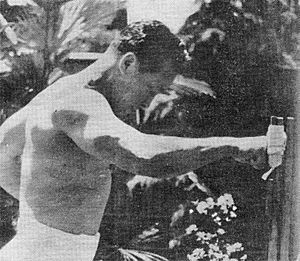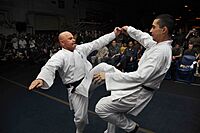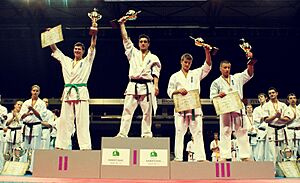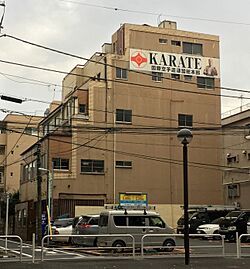Kyokushin facts for kids
 |
|
|---|---|
| Logo of Kyokushin-kai which written in kanji | |
| Focus | Striking |
| Hardness | Full-contact |
| Country of origin | |
| Creator | Masutatsu Oyama (Choi Bae-Dal) |
| Famous practitioners | (see notable practitioners) |
| Ancestor arts | Gōjū-ryū, Shotokan, Bogutsuki Karate |
| Descendant arts | Kudo, Ashihara, Enshin, Seidokaikan, Shidokan, Satojuku, Seidō juku, Dutch Kickboxing |
| Korean name | |||||||
|---|---|---|---|---|---|---|---|
| Hangul | 극진회관 | ||||||
| Hanja | 極眞會館 | ||||||
|
|||||||
| Japanese name | |||||||
| Hiragana | きょくしんかいかん | ||||||
| Katakana | キョクシンカイカン | ||||||
| Kyūjitai | 極眞會館 | ||||||
| Shinjitai | 極真会館 | ||||||
|
|||||||
Kyokushin (pronounced Kyok-oo-shin) is a powerful style of karate that started in Japan. It's known for its full-contact fighting, where people hit and kick with strength. This martial art is built on ideas of getting better at what you do, being disciplined, and training very hard.
The main organization for this style, called Kyokushin Kaikan, was created in 1964. It was founded by a Korean-Japanese master named Masutatsu Oyama. Before this, it was known as the Oyama Dojo. Since 1964, Kyokushin has grown huge, spreading to over 120 countries. It's now one of the biggest martial arts groups in the world, including in Japan.
Contents
- Discovering Kyokushin's Journey
- Kyokushin Training and Techniques
- Exciting Kyokushin Competitions
- Kyokushin Around the World
- Kyokushin in the United States
- Kyokushin in the United Kingdom
- Kyokushin in Canada
- Kyokushin in Australia
- Kyokushin in the Netherlands
- Kyokushin in Germany
- Kyokushin in Nepal
- Kyokushin in Brazil
- Kyokushin in Poland
- Kyokushin in Hungary
- Kyokushin in Russia
- Kyokushin in Lithuania
- Kyokushin in Bulgaria
- Kyokushin in Singapore and Southeast Asia
- Kyokushin in Iran
- Kyokushin in India
- Kyokushin in Slovakia
- Kyokushin Family: Organizations and Styles
- Kyokushin's Impact on Martial Arts
- Famous Kyokushin Practitioners
- Learn More About Kyokushin
- See Also
- Images for kids
Discovering Kyokushin's Journey
How Kyokushin Karate Began
Masutatsu Oyama opened his first official training hall, or dōjō, in 1953. It was a small place behind Rikkyo University. At first, he taught a traditional karate style called Goju-ryu. But soon, Oyama started to develop his own unique karate ideas.
His teaching focused on making students stronger for real fights. This meant practicing kumite (sparring) where students directly hit their opponent's body with punches or kicks. This was very different from other karate schools at the time. Over the next ten years, Oyama worked hard to build his organization. He also traveled the world to show off his karate skills and help the style grow.
Around 1956, Oyama changed the name of his school to "Oyama Dojo." In the early days, he didn't teach new students directly. Instead, experienced teachers like Eiji Yasuda and Kenji Kurosaki helped the newcomers. On December 6, 1959, Hirofumi Okada was the first person at the Oyama Dojo to earn a black belt.
In April 1964, Mas Oyama officially created the 'International Karate Organization Kyokushin Kaikan'. This group is often called IKO or IKOK. Oyama became the director, guiding the organization as it expanded. In June of the same year, the main dojo was finished in Ikebukuro, Tokyo.
Oyama carefully chose instructors who were good at promoting the style. He would send an instructor to a new town. The instructor would show their karate skills in public places. Soon, people in the area would hear about it, and the dojo would gain many dedicated students. Kyokushin grew by connecting with other martial artists and holding matches.
Oyama also sent instructors to other countries. For example, Kenji Kurosaki went to the Netherlands, and Steve Arneil went to Great Britain. This helped spread Kyokushin worldwide. Many students, like Steve Arneil and Jon Bluming, even traveled to Japan to train with Oyama himself. Kyokushin also worked with famous people and used media to attract more fans and students.
In 1969, Oyama held the first All-Japan Full Contact Karate Open Championships. Terutomo Yamazaki was the first champion. These championships have been held every year since. In 1975, the first World Full Contact Karate Open Championships took place in Tokyo.
Kyokushin Karate became known as "Kenka Karate," or "Brawling Karate." Oyama didn't like this nickname. At its peak in the 1990s, when Oyama was still alive, Kyokushin had over 1,000 official dojos in 123 countries. It had about 12 million members.
Challenges and New Groups
Even before Mas Oyama passed away in 1994, some groups started to break away from his main organization, the IKO. For example, in 1980, Jon Bluming from the Netherlands left to start his own group, the BKK. In 1991, Steve Arneil also left the IKO to create the IFK, the International Federation of Karate.
The IKO Leadership Change
In April 1994, Oyama died from lung cancer at age 70. He didn't clearly name who should take over. This caused a lot of confusion and problems for Kyokushin around the world. The organization split into many different groups.
After Oyama's death, the International Karate Organization (IKO) divided into two main groups. This happened because of disagreements over who should lead. One group, led by Shokei Matsui, became known as IKO-1. Another group, led by Yukio Nishida, was called IKO-2. There were claims that Oyama had named Matsui as his successor. However, this was disputed by Oyama's family and even Matsui himself.
Today, there are several IKO organizations. These include IKO1 (led by Shokei Matsui), IKO2 Shinkyokushinkai (led by Kenji Midori), IKO3 (Y. Matsushima), and IKO4 (T. Tezuka).
Kyokushin Training and Techniques
Kyokushin Karate training has three main parts. These are technique, forms, and sparring. In Japanese, they are called the three "K's": kihon (basics), kata (formal sequences of moves), and kumite (sparring).
Understanding Kata Forms
Kata are like choreographed dances of combat moves. They help you practice fighting techniques in a set pattern. In Kyokushin, kata are divided into Northern and Southern types.
The northern kata come from the Shuri-te karate tradition. They are based on Shotokan karate, which Oyama learned from Gichin Funakoshi. The southern kata come from the Naha-te karate tradition. Most of these are from Goju-ryu karate, which Oyama learned from So Nei Chu and Gogen Yamaguchi.
There are also Ura Kata. These are "reverse" kata where all moves are mirrored. Oyama created them to help students improve their balance and circular techniques against multiple opponents.
| Northern Kata | |
|---|---|
| Kata name | Description |
|
The Taikyoku kata were first created by Gichin Funakoshi, who founded Shotokan karate. |
|
The 5 Pinan katas are also known as Heian in some styles. They were created in 1904 by Ankō Itosu, a master of Shuri-te. Pinan means Peace and Harmony. |
| Kanku | This kata was originally called Kusanku. It is thought to have been taught by a Chinese martial artist in Okinawa. Kanku means "sky watching." |
| Sushiho | Sushiho is a changed version of an old Okinawan kata. It is known as Gojushiho in Shotokan. The name means "54 steps," which is a symbolic number in Buddhism. |
| Bassai | This is a very old Okinawan kata with unknown beginnings. Bassai means "to storm a castle." It was removed from Kyokushin in the 1950s but brought back by some groups after Oyama's death. |
| Tekki | This is a very old Okinawan kata, also called Tekki in Shotokan. It means "iron horse." It was also removed from Kyokushin in the 1950s but reintroduced by some groups. |
|
Unique to Kyokushin. Masutatsu Oyama created these three kata to help students improve their kicking skills. Sokugi means Kicking, and Taikyoku means Grand Ultimate View. They were added to Kyokushin after Oyama passed away. |
| Southern Kata | |
|---|---|
| Kata name | Description |
|
Gekisai was created by Chojun Miyagi, who founded Goju-ryu karate. The name Gekisai means "attack and smash." |
| Tensho | Tensho comes from Goju-ryu and was developed by Chojun Miyagi. It is based on the ideas of points and circles in Kempo. Oyama saw it as an advanced kata. The name means "rotating palms." |
| Sanchin | Sanchin is a very old kata with roots in China. The name means "three points" or "three battles." The Kyokushin version is like the one taught by Kanryo Higashionna. |
| Saifa (Saiha) | This kata has Chinese influences. Its name means "smash and tear down." It may have come from China with Kanryo Higashionna or been developed by Chojun Miyagi. |
| Seienchin | This is an old Chinese kata, also brought to Okinawa by Kanryo Higashionna. The name roughly means "grip and pull into battle." |
| Seipai | This is another old Chinese kata brought by Kanryo Higashionna. The name means the number 18, which is important in Buddhism. |
| Yantsu | Yantsu is an old kata with unknown origins. It is also practiced in Motobu-ha Shitō-ryū. The name Yantsu means "keep pure." |
| Tsuki no kata | This kata was created by Seigo Tada, who founded the Seigokan branch of Goju-ryu. How it came to Kyokushin is not fully known. |
| Garyu | Unique to Kyokushin. This kata was created by Oyama himself. He named it after his pen name, Garyu. |
| Ura Kata | |
|---|---|
| Kata name | Description |
| Taikyoku sono ichi ura | |
| Taikyoku sono ni ura | |
| Taikyoku sono san ura | |
| Pinan sono ichi ura | |
| Pinan sono ni ura | |
| Pinan sono san ura | |
| Pinan sono yon ura | |
| Pinan sono go ura | |
Sparring in Kyokushin (Kumite)
Sparring, also known as kumite, helps students use their techniques in a fight. It's a very important part of Kyokushin training, especially for advanced students.
In most Kyokushin groups, you can't punch or elbow the head or neck. However, kicks to the head, knee strikes, punches to the upper body, and kicks to the legs are allowed. For training, students often wear gloves and shin guards. Children usually wear headgear to protect themselves. In training, the goal is to perform strikes correctly, not to hurt your partner. But in tournaments, the goal is to knock down your opponent. Full-contact sparring in Kyokushin is seen as the ultimate test of strength, endurance, technique, and spirit.
Earning Your Belt: Grading
The colored belts in Kyokushin come from Judo. The training uniform, called a gi or dōgi, also comes from Judo. The belt colors show your rank, or kyu. The order of colors can be a little different between Kyokushin groups. For example, some groups use orange belts for 10th and 9th kyu, while others might use red.
- Kyu ranks
- Dan Ranks
| Dan | Rank | Gold stripe(s) |
|---|---|---|
| Shodan (初段 or しょだん) | 1st | One |
| Nidan (二段 or にだん) | 2nd | Two |
| Sandan (三段 or さんだん) | 3rd | Three |
| Yondan (四段 or よんだん) | 4th | Four |
| Godan (五段 or ごだん) | 5th | Five |
| Rokudan (六段 or ろくだん) | 6th | Six |
| Shichidan (七段 or しちだん) | 7th | Seven |
| Hachidan (八段 or はちだん) | 8th | Eight |
| Kudan (九段 or きゅうだん) | 9th | Nine |
| Judan (十段 or じゅうだん) | 10th | Ten |
Exciting Kyokushin Competitions
Many tournaments are held by different Kyokushin organizations. Some of the most famous competitions include:
- Kyokushin World Tournament Open
- Kyokushin World Cup in Weight Categories
- Kyokushin All Japan Openweight Tournament
- Kyokushin All Japan Open in Weight Categories
- Kyokushin European Openweight Championships
- Kyokushin European Championships in Weight Categories
Kyokushin Around the World
Kyokushin is popular worldwide, with over 12 million people practicing it in the last 40 years.
Kyokushin in the United States
Bobby Lowe opened the first Kyokushin dojo outside Japan in Hawaii in 1957. After him, Oyama sent other instructors like Miyuki Miura and Shigeru Oyama to start dojos in the mainland United States.
Kyokushin in the United Kingdom
Steve Arneil brought Kyokushin Karate to the United Kingdom. He traveled to London in 1965 to help establish Kyokushin there. The British Kyokushinkai Karate organization was founded that same year.
Kyokushin in Canada
Tats Nakamura introduced Kyokushin to Canada in 1992 in Vancouver, British Columbia. Shihan Stuart Corrigal (7th degree black belt) is currently the main representative for Kyokushin Karate in Canada.
Kyokushin in Australia
Mamoru Kaneko and Shigeo Kato brought Kyokushin to Australia.
Kyokushin in the Netherlands
Jon Bluming and Kenji Kurosaki introduced Kyokushin to the Netherlands. On January 2, 1962, Jon Bluming created the first European karate association, the NKA. This new school quickly became strong and popular.
Kyokushin is a big part of the Dutch martial arts scene. It helped create "Dutch-style Kickboxing," which is popular in gyms like Mejiro Gym.
Kyokushin in Germany
Today, there are several national Kyokushin groups in Germany. These include the KKD, DKO, and IKOK-D. Some are part of IKO1 internationally, while others are with WKO/IKO2.
Kyokushin in Nepal
Daman Basnet is the founder and chairman of the Nepal Academy of Kyokushin Karate (NAKK). He was appointed by the International Karate Organization Kyokushin Kai-kan Japan. He has organized many tournaments in Nepal and participated in international competitions.
Kyokushin in Brazil
Seiji Isobe introduced Kyokushin to Brazil. In 1972, Mas Oyama asked Isobe to promote and set up dojos in South America. Isobe then moved to Brazil and became the head of Kyokushin there.
Kyokushin in Poland
Andrzej Drewniak is known for bringing Kyokushin to Poland. In 1972, he started the first Polish Kyokushin Karate section. In 1974, he became the Polish middleweight champion. He also earned the first Polish black belt in Kyokushin.
Thanks to Loek Hollander, Drewniak received a scholarship and invitation to Japan. He trained for 15 months under Sosai Masutatsu Ōyama and earned his 4th dan.
The "World Oyama Karate" style, founded by Shigeru Ōyama, has its largest number of students in Poland. Hanshi Jan Dyduch is now the director of this organization.
Kyokushin in Hungary
In Hungary, István Adámy and Kálmán Furkó are credited with starting Kyokushin. By the mid-1980s, nearly ten thousand people practiced Kyokushin Karate in Hungary.
Hungary is famous for hosting the Ibutz Oyama Cup three times in Budapest. Kyokushin founder Masutatsu Ōyama visited Hungary in 1983 and oversaw these tournaments.
Kyokushin in Russia
The founder of Kyokushinkai karate in the USSR is Alexander Ivanovich Tanyushkin. He met Andrzej Drewniak in Poland and started practicing karate. Tanyushkin opened the first Kyokushinkai section in Moscow in 1973.
After karate was allowed again in 1989, Tanyushkin created the Kyokushinkai Federation of the USSR. This helped martial arts grow a lot in the country. Today, many different Kyokushin Federations operate in Russia.
Kyokushin in Lithuania
Most Kyokushin Clubs in Lithuania belong to Kenji Midori's WKO Shin-Kyokushin organization. There are also two IKO-1 clubs in Marijampolė and Vilnius.
Kyokushin in Bulgaria
Bulgaria is well-known in the Kyokushin Karate world. Two Bulgarian karatekas have shown great skill in many international, European, and world championships.
- Zahari Damyanov: 4 times European and absolute world champion.
- Ivanka Popova: Absolute European champion.
Kyokushin in Singapore and Southeast Asia
Shihan Peter Chong introduced Kyokushin to Singapore and most of South East Asia. He opened the first Kyokushin Dojo in Singapore in 1968.
Kyokushin in Iran
Iranian Kyokushin fighters have done very well in top-level competitions. Iran is especially successful in the Kyokushin World Tournament Open hosted by the IKO3 / Matsushima Group.
Kyokushin in India
Sensei Abhijit Seal introduced Kyokushin karate to India. While Indian fighters haven't been very successful in international tournaments yet, the future looks promising. Kyokushin Union India is the official organization.
Kyokushin in Slovakia
Norbert Rácz (now 5th dan) introduced Kyokushin to Slovakia in 1994. He has been the Chairman of the Slovak Kyokushin Karate Association since 1998.
Kyokushin Family: Organizations and Styles
Main Kyokushin Organizations
After Oyama's death, many different Kyokushin organizations appeared.
International Karate Organization (IKO)
The name of the original organization is used by several groups:
- IKO Sosai Kyokushinkaikan: This organization is run by the Oyama family. Hanshi Flemming Jinzen Schrøter is the President.
- IKO Kyokushinkaikan / Kyokushin Matsui Group (IKO-1): After Mas Oyama died, Shokei Matsui was named his successor. However, many questioned this, and the will was later found invalid. Many senior students left to form their own groups. Kancho Shokei Matsui is the current CEO.
- IKO Matsushima (IKO-3): This group was started in 1998 and is led by Yoshikazu Matsushima.
- Kyokushin Karate Tezuka Group (IKO-4): Founded by Toru Tezuka, now led by Yoshimichi Mori.
- All Japan Kyokushin Union / Kyokushin Rengōkai (IKO-5 Kyokushinkaikan): This is a group of independent organizations. Yasuhiro Shichinohe is the chairman.
- IKO Kyokushinkaikan Sakamoto Group: Started by Shigenori Sakamoto. It operates in Japan and other countries like Iran and India.
- IKO Kyokushinkaikan World So-Kyokushin: Led by Daigo Ohishi.
- IKO World Kyokushin Kaikan: A group started in 2018 in the Kyushu area. Led by Ryuko Take.
- IKO World Zen-Kyokushin: Led by Takuma Koketsu.
Other Major Japanese Organizations
These Japanese Kyokushin organizations don't use the official "IKO" or "Kyokushinkaikan" name.
- NPO World Karate Organization Shinkyokushinkai (WKO, formerly IKO2): Led by Kenji Midori, this is likely the largest Kyokushin organization today.
- Kyokushin-Kan International (KI): Founded by Kaicho Hatsuo Royama and led by Kancho Hiroto Okazaki. Its goal is to follow Oyama's original spirit.
- IBMA (International Budo-Man Association) Kyokushin Karate Masuda Dojo: Led by Akira Masuda.
- KWU (Kyokushin World Union): Founded in 2011. It was created to replace the Kyokushin-Kan Alliance.
- Kyokushin Budo Karate Organization Kyokushin Kenbukai: Led by Masahiro Kaneko.
Major Organizations Outside Japan
- IFK (International Federation of Karate): Started by Steve Arneil in 1991 after leaving Oyama's IKO.
- KWF (Kyokushin World Federation): Founded by Shihan Loek Hollander. The current president is shihan Antonio Pinero.
- IBK (International Budokai Kan): Founded by former IKO member Jon Bluming. It focuses on self-defense and includes judo-like throws.
- Internationale Budo Kai: Led by Gerard Gordeau.
- IKAK (International Karate Alliance KyokushinRyu): Founded by Peter Chong.
- IKU (International Kyokushin Union): Founded by former IKO member David Farzinzad.
- IKA (International Kyokushinkai Association): Founded by former IKO member Carlos Costa.
- IKKF (International Kyokushinkai Karate Federation): Founded by former IKO member Teyub Azizov.
- WKB (World Kyokushin Budokai): Led by Pedro Roiz, it follows IBK rules.
- IBKO (International Budo Karate Organization): Founded in 2011, led by Tomokichi Anzai.
- KKFI (Kyokushin Karate Foundation of India): Founded in 2013, led by Vasant Kumar Singh.
Styles Influenced by Kyokushin
Kyokushin has inspired many other karate styles:
- Ashihara Karate: Founded by Hideyuki Ashihara. It focuses on self-defense.
- Enshin Karate: A competition style of Ashihara Karate, founded by Jōkō Ninomiya.
- Seidokaikan: A full-contact karate style from Kyokushin by Kazuyoshi Ishii. Seidokaikan created the first professional full-contact karate tournament.
- Seidō juku: Founded by Tadashi Nakamura.
- Satojuku: Started by Katsuaki Sato in 1977. It focuses on precise knockdown techniques.
- Shidōkan: Founded by Yoshiji Soeno.
- Seiwakai: Founded by Ademir da Costa in Brazil. It's an aggressive style aiming for knockouts.
- World Oyama: Started by Shigeru Oyama in the United States. His younger brother, Yasuhiko Oyama, now leads it.
- Sei Budokai: Led by Hanshi Leonardo Voinescu.
Some styles from Kyokushin, like Kūdō, have changed to mixed martial arts rules.
Kyokushin's Impact on Martial Arts
Kyokushin has greatly influenced other styles, especially the knockdown karate competition format. Many karate styles that came from Kyokushin, like Ashihara Karate and Enshin Karate, also use similar full-contact rules.
Many top kickboxers, such as Andy Hug and Francisco Filho, started in knockdown karate. The famous K-1 kickboxing tournament came from the Seidokaikan karate organization, which itself grew out of Kyokushin.
Kyokushin is also the foundation for "glove karate." This is a knockdown karate style where fighters wear boxing gloves and can punch to the head. Glove karate rules are used in Kyokushin Karate Iran.
Famous Kyokushin Practitioners
Learn More About Kyokushin
- Masutatsu Oyama. What Is Karate? HarperCollins (1966) ISBN 0-87040-147-5
- Masutatsu Oyama. Vital Karate. Japan Publications Trading company. Tokyo, San Francisco. 1967–1974. ISBN 0-87040-143-2
- Masutatsu Oyama. This Is Karate. Japan Publications. (1973) ISBN 0-87040-254-4
- Masutatsu Oyama. Advanced Karate. Japan Publications (2000) ISBN 0-87040-001-0
- B. Lowe. Mas Oyama's Karate. ISBN 0-668-01140-8
See Also
- Comparison of karate styles
Images for kids





